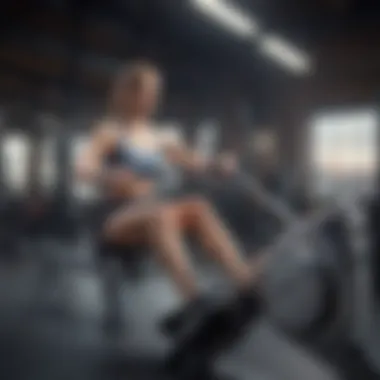Exploring Effective Workout Machines for Fitness Goals


Intro
In the fast-paced world of fitness, the array of workout machines available can be overwhelming. With each piece of equipment tailored for distinct goals, it becomes essential to dissect their features and benefits. Fitness enthusiasts, regardless of their experience level, crave insights that will help them navigate their equipment choices with precision.
As we move through this examination of popular workout machines, we’ll delve into their health benefits and practicality in everyday routines. From the humble treadmill to the more sophisticated rowing machine, there are treasures hidden in each corner of the gym.
To start, understanding the health benefits these machines offer is vital. Not only do they facilitate physical transformations, but they also significantly contribute to mental wellbeing, reinforcing the interconnectedness of body and mind in fitness journeys.
Prologue to Workout Machines
In today's fast-paced world, maintaining a healthy lifestyle hinges not only on personal discipline but also on the availability and effectiveness of exercise equipment. This article dives into an essential aspect of fitness: workout machines. These machines are tailored tools designed to maximize exercise efficiency, from improving cardiovascular health to enhancing muscle strength.
The importance of understanding workout machines lies in the fact that the right equipment can transform a rudimentary workout into an effective routine. By dissecting various types of machines—ranging from those focused on cardiovascular benefits to those aimed at strength training—this piece aims to equip readers with comprehensive insights. Recognizing what each machine offers can lead to more personalized and effective fitness journeys, avoiding the one-size-fits-all approach that often leads to frustration and abandonment of fitness goals.
The Evolution of Fitness Equipment
Throughout history, fitness equipment has undergone a remarkable transformation. Gone are the days when a simple wooden plank or heavy rocks were the main means of building strength. The 20th century, in particular, saw a surge in innovative designs:
- The introduction of stationary bikes for indoor cycling
- The rise of the resistance training machines that allow for a slew of techniques without needing a spotter
- Recent trends toward digitally enhanced machines that offer guided workouts through apps and screens
This evolution reflects society's growing understanding of tailored fitness. As lifestyles change and technology advances, so too do the demands placed on fitness manufacturers. What started as practical tools have now morphed into sophisticated equipment that not only tracks performance metrics but also engages users through interactive platforms.
Why Workout Machines Matter
Workout machines play a pivotal role in shaping a well-rounded fitness regimen. Here’s why they matter:
- Targeted Muscle Engagement: Different machines focus on specific muscle groups. For instance, a rowing machine provides a full-body workout, while a leg press targets the lower body.
- User-Friendly Options: Many machines are designed with ease of use in mind. Beginners, in particular, can benefit greatly from guided movements, which help them learn proper techniques without risking injury.
- Sustainable Workout Options: Those juggling a tight schedule can find machines that facilitate efficient workouts, delivering maximum results in minimum time.
"The right machine can make the difference between a mundane workout and a rewarding fitness routine. Understanding their functionalities means better choices in the fitness journey."
At the end of the day, selecting the right workout equipment goes beyond personal preference or brand hype. It’s about aligning the capabilities of the machine with individual fitness goals and the unique benefits they bring to the table.
Cardiovascular Machines
Cardiovascular machines hold a pivotal role in fitness routines, serving to enhance heart health, bolster endurance, and assist in weight management. They are designed to engage large muscle groups in a rhythmic, continuous manner, which promotes cardiovascular fitness. For many fitness enthusiasts and novices alike, these machines are often seen as the gateway to regular exercise.
The beauty of cardiovascular machines such as treadmills, stationary bikes, and elliptical trainers lies in their versatility. They can be tailored to fit the user’s individual fitness level and preferences, making them accessible to a diverse audience. Understanding their functions, advantages, and the potential hurdles can significantly influence workout efficacy and enjoyment.
Treadmills
The treadmill tends to be the stalwart of gyms everywhere. Whether it’s the classic model or a modern version equipped with advanced technology, this machine remains a favorite.
Features and Benefits
Treadmills typically come with a range of features, including adjustable incline options, varied speed settings, and digital interfaces that track performance metrics like distance, calories burned, and heart rate. This adaptability allows users to customize their workout experience. One of the most appealing aspects is the ability to simulate outdoor running or walking, appealing to those who may not feel comfortable outside due to weather or safety concerns. However, the continuous impact on joints can be a downside for some users, making proper footwear and technique essential for injury prevention.
Best Practices for Use
To get the most out of a treadmill session, it’s vital to warm up properly. A steady start at a lower speed allows the body to acclimatize. Incorporation of incline variations can intensify workouts and avoid monotony. Furthermore, maintaining a proper posture—keeping the back straight and not leaning on the handles—maximizes effectiveness while minimizing strain. Other best practices involve alternating between jogging and walking intervals to build strength and endurance without burning out.
Common Misconceptions
Many people think treadmills are solely for running, but this perception limits their potential. While they are excellent for running, treadmills also cater to walkers, joggers, and interval trainers alike. Another prevalent myth is that the machine does all the work, which isn't true. Users have to engage actively for the workouts to be effective. Understanding that one must push themselves—regardless of the ‘automatic’ settings—can lead to more productive sessions.


Stationary Bikes
Stationary bikes have also gained popularity, providing a different but equally beneficial option in the realm of cardiovascular workouts.
Different Types: Upright vs. Recumbent
Upright bikes mimic the feel of traditional cycling, often providing a more intensive workout by engaging core muscles. In contrast, recumbent bikes offer back support and a more relaxed position, making them ideal for those with back issues. The choice between upright and recumbent bikes ultimately hinges on personal comfort and fitness goals. Each type has its unique advantages. For instance, upright bikes engage more muscle groups but may not suit everyone comfortably. Recumbent models, while easier on the back, may not provide the same level of challenge.
Engagement and Efficiency
Both types of stationary bikes can be excellent for calorie burning and improving cardiovascular health. Engagement can be maximized through interval training or steady-state rides, depending on the user's fitness level. The efficiencies seen on stationary bikes—combined with the ability to read or watch shows while exercising—can cater to those with busy schedules. However, limiting oneself to low-intensity activities might not yield the desired results if fitness goals involve significant weight loss.
User Experience Considerations
User experience can vary significantly between models. Those with adjustable seats and handles can ensure a personalized fit, enhancing comfort. Moreover, built-in entertainment features like screens displaying engaging content can help maintain motivation during long workouts. However, costlier bikes may offer more features, potentially straining budgets. It's important that users assess their needs and the bike's offerings.
Elliptical Trainers
Elliptical trainers have surged in popularity in many gyms, thanks to their low-impact operation and full-body engagement capabilities.
Low Impact Workouts
One of the most enticing features of ellipticals is their low-impact design. This is particularly beneficial for those with joint concerns or injury histories, allowing for effective cardiovascular workouts without undue strain on the body. The smooth movement patterns promote more natural body mechanics. However, individuals must focus on using proper form to gain maximum benefit and avoid overcompensation during workouts.
Versatility and Adaptability
Ellipticals also shine in terms of versatility, allowing users to target various muscle groups by adjusting their posture or pedaling style. With the ability to engage both the upper and lower body, these machines provide a more comprehensive workout. However, some users may feel overwhelmed by the multiple workout settings available. To avoid this, it's wise for beginners to start simple and gradually explore advanced features as they gain confidence.
Potential Downsides
While the benefits are many, nothing is perfect. Some potential downsides include that users may get too complacent with the low resistance settings, limiting their progression. Additionally, the movement can sometimes lead to a feeling of unnatural motion for some. Keeping this in mind is crucial for users seeking effective workouts. Understanding the various settings and keeping a varied workout regimen can combat complacency and maintain challenge levels.
Strength Training Machines
Strength training machines play a essencial role in an effective fitness regimen. They not only provide a structured approach to weight lifting, but they also cater to users of varying fitness levels. Their design typically focuses on isolating specific muscle groups, making it simpler for newcomers to learn proper form and technique. Additionally, for seasoned individuals, they offer the ability to consistently track progress.
The importance of strength training machines can’t be overstated. They help in building lean muscle, which can boost metabolism and enhance overall physical performance. Moreover, with the easiness of adjustments, anyone can find their perfect fit, whether they are lifting for strength, body toning, or rehabilitation.
Weight Machines vs. Free Weights
Understanding the Difference
The main distinction between weight machines and free weights comes down to the structure and form each provides during exercises. Weight machines often offer guided movements, while free weights rely on the user to stabilize their bodies through a wider range of motion. This stabilization is crucial for developing overall strength and balance.
Weight machines can be particularly beneficial for beginners who might feel overwhelmed with free weights, as they reduce the chance for injury by guiding the movement. A significant advantage of using machines is that they often target specific muscle groups effectively, making it easier for users to focus their workouts.
Advantages of Each
Weight machines offer the advantage of providing a controlled motion and guided support, which is invaluable for beginners or those rehabilitating from injury. In contrast, free weights allow greater freedom of movement and can engage stabilizing muscles, fostering overall muscle coordination. The choice between these two largely depends on a person's fitness goals.
- Weight Machines: Great for targeting specific muscles with little risk of injury.
- Free Weights: Foster muscle coordination and greater overall strength.
Best Practices for Implementation


To get the most out of either weight machines or free weights, understanding proper technique is vital. For weight machines, it’s important to adjust the seat and weights correctly to match one’s body size and ability. Users should also start with lighter weights to master the form before progressing to heavier weights. When using free weights, it’s beneficial to work with a partner or a trainer, especially if you’re just starting out.
Cable Machines
Versatility in Workouts
Cable machines stand as a versatile option within workout settings. They allow for a diverse range of exercises, enabling users to target multiple muscle groups in one session. Their unique cable-and-pulley system lets individuals adjust the angle of resistance, providing flexibility unmatched by many other machines. This versatility can cultivate creativity in workouts and keep routines engaging.
- Machines’ versatility allows for diverse exercises.
- Adapting resistance and angles offers varied training stimulus.
Targeting Specific Muscle Groups
With cable machines, targeting specific muscle areas becomes easy. By adjusting the cable height and positions, users can focus on everything from biceps to triceps, to more complex movements like lateral raises. This capability makes cable machines a favored choice for those looking to sculpt their bodies precisely. For fitness enthusiasts aiming for comprehensive training, cable machines support a variety of exercises in one place.
Safety and Technique
While cable machines promote an engaging workout experience, users must prioritize safety and proper technique. Maintaining control over the weights and focusing on form are essential to prevent injury. Unlike some free-weight exercises, cable machines inherently guide the movement, but users should still be cautious about the weight they choose to use.
Smith Machines
Structure and Safety Features
Smith machines offer a unique structural design with a barbell that moves along fixed paths. This feature enhances safety, especially for those working out alone. The guided path can also help ensure that exercises are performed in a controlled manner, minimizing the risk of injury. Smith machines can vary in their design and functionality, but their core benefit remains consistent: safety during lifting.
- Fixed bar path enhances user safety.
- Allows for focused exercises with reduced risk.
Best Exercises to Perform
When considering the best exercises for smith machines, squats, bench presses, and overhead presses should top the list. These exercises engage various muscle groups and can be modified to fit a variety of fitness levels. Furthermore, by working with the Smith machine, users can gradually increase their lifting capacity while maintaining proper technique due to the machine’s tailored design.
- Popular exercises: Squats, bench presses, overhead presses.
- Gradual increase in weight promotes steady progress.
Comparative Analysis with Other Machines
In comparing Smith machines to their free weights counterparts, one key aspect is control. Smith machines allow for guided movements, making them less intimidating for beginners. On the other hand, free weights encourage a fuller range of motion and engagement of stabilizing muscles. Thus, while Smith machines provide a structured workout, free weights offer more comprehensive muscle engagement. For those focused on building foundational strength, integrating both types can optimize results.
Effective strength training often involves balancing between guided machines and free weights, providing a well-rounded approach tailored to personal goals.
Specialized Fitness Machines
Specialized fitness machines play a crucial role in today’s workout regimens, focusing on targeted approaches towards achieving health and fitness objectives. These machines are designed with specific functionalities to enhance exercise efficiency and provide unique benefits that standard equipment may not offer. One of their most prominent advantages is the ability to cater to various fitness levels, making them accessible for novices and seasoned athletes alike. Additionally, the intricate mechanisms help you isolate muscle groups, supporting defined strength training goals. Hence, if someone has certain physical limitations or needs to focus on distinct areas of their body, specialized machines often become indispensable.
Rowing Machines
Full-Body Engagement
Rowing machines are well-known for their full-body engagement capabilities that set them apart from many other workout equipment. This characteristic means you are not just exercising one muscle group; instead, you work out your legs, core, and arms simultaneously. This comprehensive engagement elevates calorie burn and improves cardiovascular fitness. Moreover, rowing provides balanced muscle development, promoting overall strength without overly stressing a single area, which can lead to injuries when not careful. This makes rowing machines a popular choice for individuals looking to effectively maximize their workout efforts.
Techniques for Effective Use
For users to reap the full benefits of rowing machines, adopting proper techniques is fundamental. The key is to maintain strong form throughout each pull, focusing on using your legs first before engaging your upper body. Proper technique not only enhances workout efficiency but also minimizes injury risks. Many users overlook the importance of a warm-up before hopping on this equipment, which can lead to discomfort. A conscientious approach, ensuring smooth transitions during strokes and breathing evenly, is essential to gain the most out of every session on the machine.
Common Workouts and Their Benefits


Rowing machines offer a variety of workouts that cater to different fitness goals, such as endurance training or sprint intervals. The diversity is one of its prominent benefits; you can tailor the intensity according to your capabilities or goals. For instance, long steady-state rows are excellent for stamina building, whereas shorter, high-intensity sprints work wonders for those looking to shed weight or enhance speed. Incorporating a range of workouts can keep sessions engaging and help track progress effectively, leading to better results over time.
Multi-Station Gym Systems
Convenience of All-in-One Systems
Multi-station gym systems provide a convenient solution for those wishing to perform various exercises without the need for multiple pieces of equipment scattered throughout a space. These systems often come packed with attachments and stations for different muscle groups, allowing users to switch seamlessly from one exercise to another. This user-friendly approach is immensely helpful, particularly for those with limited time at the gym, as it allows for efficient, structured workouts. Though relatively larger, the convenience they offer can be invaluable, especially in a home gym setup.
Assessing Space and Budget
When considering a multi-station gym system, assessing your available space and budget is essential. These setups can be an investment, and it is crucial to understand your needs and preferences before making a purchase. Some machines require significant floor space, while others are designed to fit in tighter areas. Evaluating your budget is equally relevant, as some systems come with high price tags that may deter potential buyers. A pragmatic assessment ensures that your investment aligns with your fitness ambitions and available resources.
Considerations for Home vs. Gym Use
Differentiating between home and gym usage of multi-station systems holds importance in determining which model to invest in. For instance, home systems might be designed for compactness and ease of use, while gym systems may emphasize durability and a broader range of functions. Understanding the intended environment guides your decision-making process, as residential setups focus on accessibility and convenience whereas commercial equipment prioritizes longevity and robustness. The choice you make should align with both your fitness routine and your environment.
Selecting the Right Equipment
Choosing the right workout equipment is like picking the perfect shoes for a long journey. If you don't get it right, you may end up uncomfortable, or worse, sidelined from the activity altogether. This section highlights the significance of selecting appropriate machines for your fitness endeavors. By aligning your equipment choice with your personal goals, you can amplify the effectiveness of your workouts, ensuring that every drop of sweat contributes toward your aspirations.
When trying to figure out what to buy or use, consider what your fitness goals are. Are you looking to lose weight, build muscle, or improve your cardiovascular health? Each machine has its strengths, and understanding these can guide you toward making well-informed decisions.
Assessing Personal Fitness Goals
Your fitness journey should start with a good hard look in the mirror—figuratively speaking, of course. What are you aiming to achieve? Maybe you want to shed some extra pounds, tone your muscles, or even train for a marathon. Different workout machines cater to various objectives.
For instance, if weight loss is your main focus, you might lean toward cardio machines like treadmills or stationary bikes. These machines get your heart pumping and help you burn calories effectively. If your aim is to increase muscle strength, weight machines or cable systems might serve you better. They isolate specific muscle groups, allowing for targeted workouts.
Here are a few considerations to steer you:
- Weight Loss: Treadmills, ellipticals, rowing machines.
- Muscle Gain: Free weights, smith machines, multi-station gym systems.
- Cardiovascular Health: Stationary bikes, elliptical trainers, and rowing machines.
Reflecting on what motivates you can also play a role in your equipment selection. Do you prefer a social environment with group classes, or do you like the quiet focus of solo workouts? Knowing these preferences can help you choose machines that keep you engaged and consistent.
Space and Budget Considerations
Now, once you've sorted your goals, it's time to think about practicality. Space and budget often act as gatekeepers in the fitness equipment realm. It’s one thing to fall in love with the concept of having a multi-station gym in your living room, but quite another to actually accommodate it.
- Space: Before you start dreaming big, measure your workout area. The last thing you want is to buy a machine and find out it will turn your living room into a cramped gymnasium. Ensure adequate space around the machine for movement.
- Budget: Let’s face it: some machines come with a staggering price tag. Set a budget that suits your wallet and stick to it. You don’t need to sell your soul for a high-end model. There are plenty of mid-range options that deliver fantastic results.
In summary, while the allure of flashy machines can be hard to resist, always ground your decisions in your actual needs and living situation.
Selecting the right workout equipment involves a comprehensive assessment of personal fitness goals and realistic space and financial limitations. Focus on what serves you best rather than what looks impressive or trendy.
Ending
As we wrap up this exploration into popular workout machines, it’s vital to reflect on the insights we’ve gained. The effectiveness of each machine, be it for cardiovascular fitness or strength training, hinges on understanding personal goals and the context of usage. Choosing the right fitness equipment can significantly impact your workout consistency and overall results. It's not just about having a machine at your disposal; it’s about knowing how it fits into your fitness journey.
Besides isolating workouts or focusing on muscle groups, various machines also cater to different preferences and physical abilities. This ensures that everyone, regardless of their starting point, can engage with fitness. It’s essential to consider factors like space, budget, and personal comfort when making equipment choices. By reflecting on the nuances discussed in previous sections, individuals can navigate the bustling world of workout machines with more clarity.
"Choosing the right workout machine is like picking the right tool for a job; it can make all the difference in bringing about successful results."
Recap of Key Insights
- Diverse Machinery: There's a wide range of machines available, each designed to serve distinct purposes. Treadmills, stationary bikes, and elliptical trainers cater to our cardiovascular needs. Conversely, strength training machines like cable systems and Smith machines are tailored specifically for building muscle.
- Assessing Personal Needs: Understanding personal fitness goals serves as a framework for making equipment choices. Whether looking to build endurance, strength, or flexibility, knowing your direction can simplify decision-making.
- Environment Considerations: The space you have available will dictate the types of machines you can incorporate. Limited room might lean you toward compact, multi-station systems instead of bulky individual machines.
Encouragement for Exploration
Navigating your way through the myriad of workout machines can feel daunting. Yet, this plethora of options is also an invitation to develop a personalized fitness strategy. Don’t hesitate to explore different types or experiment with new machines that might not initially seem appealing. You never know when you might discover a workout that feels invigorating.
Investing time in understanding how each machine operates, along with their respective advantages and potential drawbacks, opens the door to more effective workouts. Whether in a gym or setting up your home area, make it a priority to familiarize yourself with what various equipment can do for your health. And remember, fitness is a journey—each step taken towards understanding and utilizing these tools brings you closer to achieving your goals.















